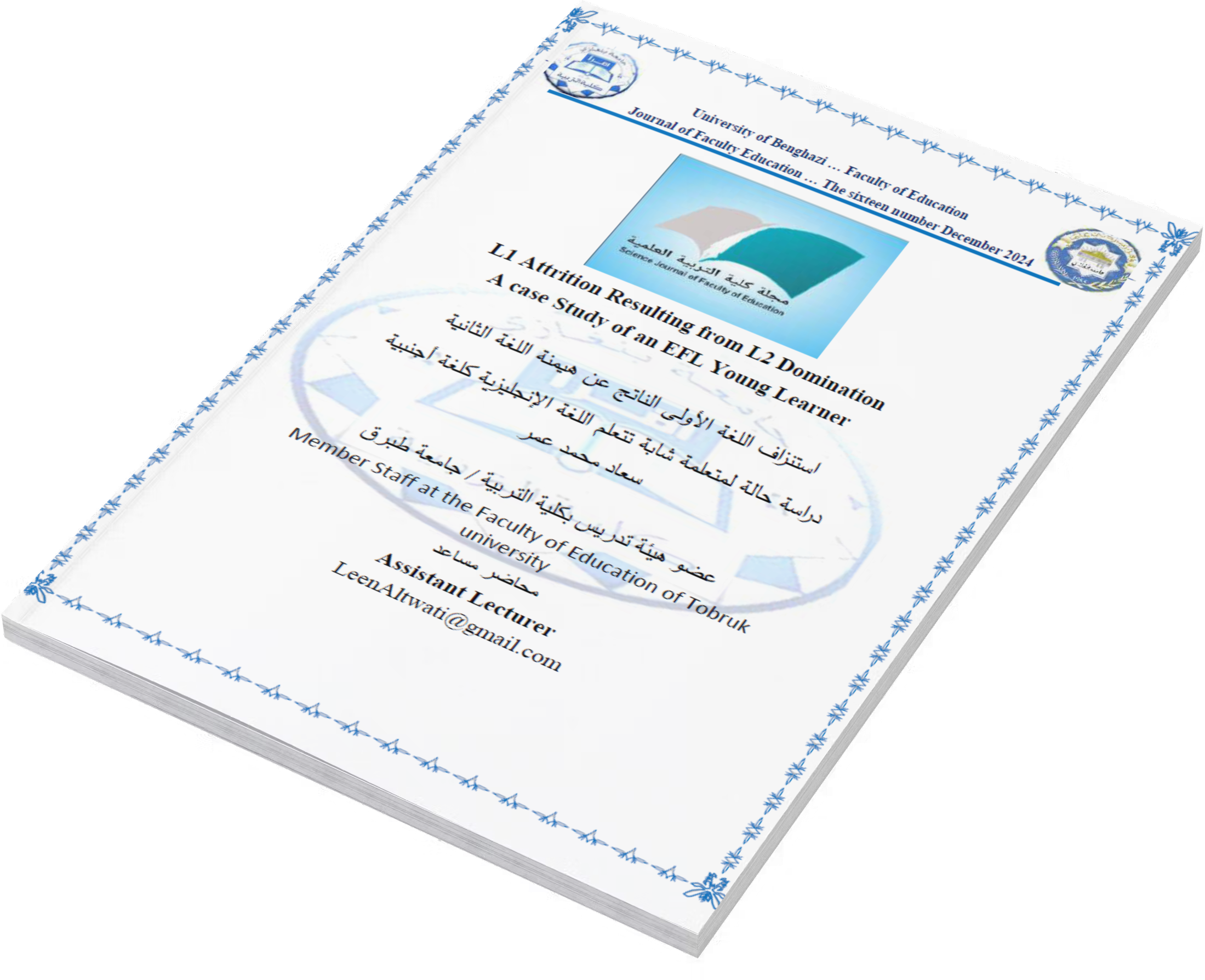L1 Attrition Resulting from L2 Domination A case Study of an EFL Young Learner
DOI:
https://doi.org/10.37376/fesj.vi16.7108Keywords:
language attrition,, language acquisition,, speech delay,, interference hypothesis,, EFL young learnersAbstract
This case study examined the phenomena of language attrition and acquisition. The objectives of the study were to describe how an EFL young learner lost her L1, but at the same time acquired another language, as well as the factors that cause them. The case of this study was a 9-year-old EFL learner. The instruments used in the study were, interview and observation. This study showed that the girl was exposed to her L1 during the speech delay period , therefore, she does not comprehend her L1 too well. On the contrary, she speaks Arabic fluently. As for the factors influencing her language attrition and acquisition, it was found that the age when she was exposed to the language plays a crucial role in determining the level of fluency of each language she acquires, and the exposure frequency with the new languages also plays an important role in her language acquisition. This aligns with the interference hypothesis, which suggests that attrition is caused by the growing influence of the dominant second language (Köpke & Schmid, 2004). This study also revealed that the case was considered a right-brain dominant child, and she subconsciously imitated the native English pronunciation and accent from watching videos on YouTube. It also indicated that she experiences the language attrition as the role of her speech delay in her language development provides more with L2 than L1.
Downloads
References
Clarke, M. (2016). Language Dominance and the Attrition of First Language Skills.
Language Learning and Teaching, 26(3), 67-90.
Cook, V. (2003). Effects of the second language on the first. Multilingual Matters.
De Bot, K. (2001). Language attrition and language shift. International Journal of
Bilingualism, 5(3), 213-221.
Kecskes, I., & Papp, T. (2000). Foreign language and mother tongue. Psychology Press.
Kommitz, H. (1984). Language Attrition in Expatriates: The Impact of Cultural and Social Factors. Journal of Multilingual and Multicultural Development, 5(1), 43-56.
Köpke, B., & Schmid, M. S. (2004). First language attrition: The next phase. In M. S. Schmid, B. Köpke, M. Keijzer, & L. Weilemar (Eds.), First language
attrition: Interdisciplinary perspectives on methodological issues (pp. 1-43).
John Benjamins.
Kupisch, T., & Rothman, J. (2016). Terminology matters! Why difference is not
incompleteness and how early child bilinguals are heritage speakers.
International Journal of Bilingualism, 22(5), 564-582.
Montrul, S. (2008). Incomplete acquisition in bilingualism: Re-examining the age factor.
John Benjamins Publishing.
Montroll, S. (2008). Language Shift and Maintenance in Bilingual Contexts: The Role of
Sociolinguistic Factors. Multilingual Matters.
Paradis, M. (2007). Bilingualism and Neuropsychology: An Overview. In F. Grosjean &
P. Li (Eds.), The Psycholinguistics of Bilingualism (pp. 223-250). Wiley-
Blackwell.
Pavlitkor, A. (2004). The Interplay between L1 Attrition and L2 Acquisition: A Case
Study. Language Learning Journal, 32(2), 143-158.
Penfield, W., & Roberts, L. (1959). Speech and brain mechanisms. Princeton University
Press.
Schmid, M. S. (2011). Language Attrition. Cambridge University Press.
Schmid, M. S., & Köpke, B. (Eds.). (2013). First Language Attrition: Interdisciplinary
Perspectives on Methodological Issues. John Benjamins Publishing.
Smith, J. (2010). The Impact of Language Immersion on L1 Attrition. Applied Linguistics, 31(2), 235-256.

Downloads
Published
How to Cite
Issue
Section
License
Copyright (c) 2024 Science Journal of Faculty of Education

This work is licensed under a Creative Commons Attribution-NonCommercial-NoDerivatives 4.0 International License.














